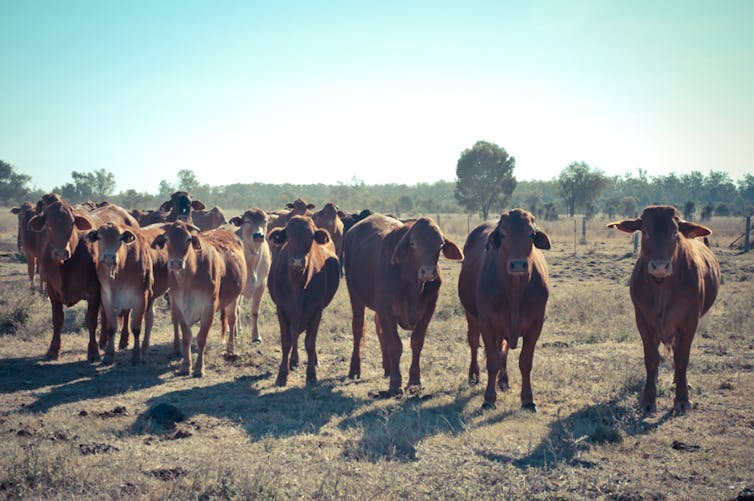The Queensland State Government has recently proposed changes to the Vegetation Management Act 1999.
Under the planned reforms, landowners will be able to clear and thin out vegetation using self-assessable codes without the need to apply for permits. This is sounding warning bells for already endangered brigalow-dominated communities.
Brigalow (Acacia harpohpylla) is a silver-leafed, black trunked tree; “brigalow” was an Aboriginal name adopted by white settlers in the 19th century. In Queensland and northern NSW, there is an area called the brigalow belt that is dominated by, you guessed it, brigalow. This same area is also hugely popular with landowners for running livestock, typically cattle, as well as growing crops like wheat, cotton and sorghum.
Over the past 50 years, much of the brigalow coverage in the area has been reduced by over 90%. In the 1950s, large areas of brigalow forest were removed for pasture improvement and cattle grazing. Heavy machinery tore open fields, with burning another favoured way for clearing.

In the 1990s, concerns grew over the extent of the clearing. The Queensland government introduced the Vegetation Management Act in 1999 (amended later by the long winded Vegetation Management and Other Legislation Amendment Act 2009). The aim was to protect “high value regrowth” for trees like brigalow to prevent landowners clearing them.
What is high value regrowth? Well the Department of Environment and Resource Management has created a map showing all of the regrowth areas. If you are a landowner and you have trees that appear on this map, then you’ll need a permit to clear them. There are of course ways to get around this.
With less than 10% of many brigalow-dominated ecological communities remaining, brigalow-dominated and co-dominated ecological communities are now classed as “endangered” under the main federal environmental legislation for Australia, the Environment Protection and Biodiversity Act (EPBC Act 1999). Endangered means that particular animal or plant is “facing a very high risk of extinction in the wild in the near future”.
Convincing cattle or crop farmers to keep brigalow is a tough argument. It is root suckering and very hardy, so you can chop it off at the base and it will quickly grow back (which is why blade ploughing, aerial spraying and burning are the favoured techniques). Cattle don’t like the taste of brigalow, and if you leave brigalow to grow in one spot of a paddock, it will slowly spread out into dense forests that are difficult for even a dirt-bike to get through.
Yet there are so many arguments why farmers in this area should maintain good sized brigalow forests on their properties.
The first one is soil health. There’s a reason why brigalow grows in these areas of Australia. The brigalow belt is renowned for its deep cracking clay soils which brigalow trees love, and they add a heap of good stuff to the soil in the area. The trees are nitrogen fixing via a bacteria in their root systems, and they provide calcium to the soil through their leaf foliage. Brigalow trees can withstand high levels of salinity and keep salinity levels in the soils stable. Clearing these trees has led to less crop production as well as less pasture grasses, meaning smaller cattle.

Land clearing encourages exotic and invasive plants, animals and insects to make a new home. These invasive species include weeds like lantana (Lantana camara) and the rubber vine (Cryptostegia grandiflora), which are a nightmare for farmers.
And brigalow holds the soil together and helps water seep down into the ground. Clearing brigalow has meant more erosion problems for farmers, increased runoff for water, and higher salinity levels in the groundwater.
Finally, these trees provide shade and shelter for not only stock but for many other animals, plants and insects. If you ever walk through a cattle paddock with stands of brigalow dotted around the place, you’ll notice the paths worn out by cattle hoofs that lead from the trees, to water, and to more trees. At noon on a hot summer’s day, you won’t find any cattle sunning themselves in the middle of the paddock. They’ll be swishing their tails in the shade of any tree they can find.
Whether you’re growing crops or pasture for cattle, if you want to have good soil, brigalow is an extremely important tree to have around. Too often, the health of the soil on a property is not valued enough. Farmers have been found to favour clearing these types of vegetation from the most fertile areas on their properties.
Putting at-risk brigalow-dominated ecosystems on the endangered list helps bring attention to this tree, but it isn’t enough. There has to be a change in attitudes and land management practices by property owners in this area.
Education is definitely one way. Financial incentives such as the Carbon Farming Initiative may be another way to encourage famers to keep existing brigalow trees on their properties. Until this happens, legislation like the Vegetation Management Act 1999 provide an important way to protect brigalow from being cleared. The proposed changes by the state government are a step backwards for the Brigalow Belt.

